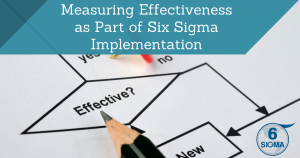
The goal of any Six Sigma Implementation project is to implement process improvements that are effective. But what, really, does it mean to be effective? And how do you know when you are effective and when you are not effective? To answer these questions you must have a system of measurement in place to verify that the process output(s) meet the needs of the customer. And that means internal as well as external customers.
What constitutes a good system of measurement? It must be data driven, it must measure the right things, and it must be visible to everyone associated with the process (directly and indirectly).
We’ll look at all of these in turn.
The Definition of Effectiveness
The basic definition of effectiveness in the context of Six Sigma implementation is as follows:
Measurements that show how well process output(s) meet the needs of customers, both internal and external.
In other words, a process output that meets the Critical-to-Quality Trees (CTQs) of the customer and creates customer satisfaction that contributes to the effectiveness of the process. Those outputs and the actual level of performance can be measured and in fact, must be measured to ensure that the process conforms to Six Sigma requirements.
It should be noted that some Six Sigma experts disagree about the appropriateness of using the term “customer satisfaction” when defining effectiveness. They argue, among other things, the following:
- Satisfaction is not a data-driven business measurement
- Satisfaction is an emotional state
- Satisfaction does not take into account other aspects such as price, brand or quality
- Satisfaction has no relation to business goals and strategies
These practitioners opt instead to focus on customer value, as they consider it a more objective and measurable standard of performance. We are not going to go into a detailed discussion of the relative merits of each of these viewpoints, but it is important that you at least have some awareness that differences exist.
Regardless of which definition you prefer, to determine effectiveness you must decide what level of performance is required. Think in terms of:
- Target value – How big, how long, how wide, and so forth.
- Variation – How many are bigger or smaller, how many are longer or shorter, how many are wider or narrower, and so forth.
- Range of Tolerance – What is the maximum acceptable amount bigger or smaller, maximum acceptable amount longer or shorter, maximum amount wider or narrower, and so forth.
When you have determined what level of performance is required you can then select the appropriate measurements to ensure that the specific level is consistently achieved.
Key Measurements of Performance
The key measurements of performance that you select when measuring six sigma implementation efficacy will vary depending on things like:
- The customer CTQs
- The product
- The service
- Market share
- Competitive Pressures
In all cases, the performance measurements of six sigma implementation must be data-driven and objective rather than qualitative and subjective. Examples might include:
- On time delivery
- Accuracy
- Defects
- Returns
- Added/optional services or features
- Number of sales
- Close rate for sales leads
- Weight of product
- Quantity of product
- Market penetration
- Number of distributors/retailers
- Repeat sales
Once you have made a list of several performance measurements to track regularly, you are ready to move on, right? Wrong!
Determine the Right Combination of Measurements
It takes more than just a list of performance measurements to properly measure the effectiveness of Six Sigma implementation. Each individual measurement may be useful and have some value, but to measure the overall effectiveness of process improvement activities it is critical that you put together the right combination of measurements.
You have to measure the right thing to get the right results. For instance, if you measure the speed of production but not the quality of production you can quickly end up with the fastest production line around that is churning out low quality products. Or, if you measure the dollar value of sales but not the repeat sales from each customer, you can end up with high-volume sales people who don’t pay close enough attention to customer service, leading to customers who take their business elsewhere.
If you measure the wrong things, or measure individual things out of proportion to each other, you will create results that are not in line with your expectations and that do not fulfill the requirements of Six Sigma process improvements.
Visibility is Important
Remember that the people who use a process have a strong need to understand how and why their efforts are essential, and to track their performance. The key measurements you select to determine effectiveness of your six sigma implementation are also valuable for communicating this important information to them. This is a powerful way to motivate the right behaviors that will institutionalize Six Sigma process improvements.
The best methods of communication are those that are accessible, visible, and clearly illustrate performance levels at a glance. Some of the most common tools for making measurements highly visible include:
- Charts
- Graphs
- Tables
- Illustrations
Some organizations print large copies of such things and post them in various places around the office or facility. Others place them on the home page of their company intranet or web portal. Still others push them out to employees via e-mail, newsletters, video monitors, broadcast announcements, and similar methods. Choose the method(s) that work best for your business and your employees for an effective six sigma implementation that’s measurable to boot.
Learn more information about 6Sigma.com’s Lean Six Sigma training coursework, available as classroom, onsite, or six sigma online training options.









No responses / comments so far.